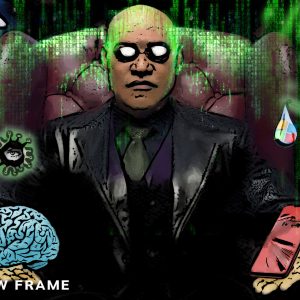Crime noir is all dressed up with everywhere to go
With its roots in the aftermath of World War II, the genre’s subversive aesthetic continues to explore the ravages of capitalist society and the meanness of modernity.
Author:
6 April 2021

Neon signs reflected in the rain. Shady business deals gone wrong. Isolated protagonists driving down deserted city streets. Stylish doom. The term “noir” may seem elusive, but you know it when you see it.
Derived from the French word for the colour “black”, noir has come to define a particular type of storytelling. It is often pessimistic and sinister, exploring a world of criminality, while at the same time glamorous and enticing. The question of exactly what qualifies as noir remains a matter of lively critical and academic discussion. But, in general, most definitions agree that it is a particular emotional tone and stylistic approach, rather than a precise genre.
While noir stories almost always involve crime and underworlds (of both the social and psychological kinds), not all crime stories are noir. For example, take the career of British actor Idris Elba, who first came to prominence playing the Baltimore gang leader Stringer Bell in The Wire. The series shares many aspects of noir stories, such as its focus on the grey areas between the police and organised crime. However, it lacked much of the surreal quality and focus on individual pathology that characterises noir.
In contrast, Elba’s portrayal of the emotionally tormented title character in the British police drama Luther is pure noir. Luther’s desires are always in flux, set against the backdrop of frigid, bleak London.
In noir, characters are both hunted by the institutions around them, but also haunted by their past and the elusive mysteries of their own psyches.
Related article:
Recent South African cultural explorations of noir range across mediums. In her debut novel, Mermaid Fillet, Mia Ardene deals with issues of violence and gender against the backdrop of contemporary Cape Town. It’s subtitled “a noir crime novel”. Filmmaker Amy Jephta’s upcoming series Skemerdans tackles the criminal underworld’s control of Cape Town’s nightclubs. The show has been described as a “Cape Flats neo-noir”. And in the recent short story collection Joburg Noir, a selection of writers tell a series of “uncompromising and gritty” narratives of South Africa’s largest city, dealing with themes from religious corruption to the migrant experience.
Describing the visual style of Skemerdans, Jephta talked about using stark contrasts of lighting and filming at twilight, as the night devoured the day: “We wanted to take these completely local settings and give them the same treatment we associate with LA noir, to make them feel as cinematic and iconic.”
How noir was born
The noir aesthetic gained its name during the aftermath of World War II. In the late 1940s, French culture was reeling from the after-effects of the Nazi occupation.
This traumatised cultural mood was expressed in the writings of existentialist philosophers Jean Paul-Satre, Simone de Beauvoir and Albert Camus. While reflecting on the fate of humanity in the age of the Holocaust and the atomic bombing of Hiroshima and Nagasaki, they also read the work of American pulp crime writers such as James M. Cain. From the late 1920s on, books like Dashiell Hammett’s Red Harvest and Cain’s Double Indemnity offered cynical dissections of the failures of American capitalism during the Great Depression.
This “hardboiled” style was a marked contrast to the crime and detective fiction that had preceded it. Earlier stories, such as the Sherlock Holmes series, had focused on investigators who upheld the social order by exposing criminal plots. In contrast, authors like Raymond Chandler called this very order into question. “The law was something to be manipulated for profit and power”, with characters living in a “world gone wrong”.
Hollywood began to adapt these books into film dramas while they were banned in France under the occupation. By 1946, they were allowed again, and audiences desperate for new American content began to notice a string of films which shared a similar aesthetic, which critics called film noir.
Related article:
This darkness referred to both the aesthetic of the movies – which used shadow and stark contrasts between black and white photography – and to their “claustrophobic” and emotional atmosphere.
Controlled by the rigid censorship of the Hays Code, Hollywood films strove to present an optimistic vision of American consumer society. Romances and musicals were full of noble cowboys and square-jawed football players. These were roles played by actors like future US president and conservative icon Ronald Reagan.
Noir, in contrast, was from an inverted, shadow world. Its characters were often antiheroes, or outright villains. It showed a state of alienation, where the police and authorities were either absent or corrupt. In place of the American dream, it highlighted failure and moral ambiguity.
As Mike Davis wrote in his classic social history of Los Angeles, City of Quartz, noir became a powerful “anti-myth” about the dark side of capitalism.
Much of this pessimism came from the experiences of both the Great Depression and World War II, where millions of people suddenly faced the uncanny, daily reality of general social instability and imminent death.
Related article:
Its aesthetic was especially influenced by anti-Nazi German filmmakers who had fled Hitler’s regime to try to find work in Californa, bringing the shadows of Berlin with them. They imported the stylistic techniques of German Expressionism, which combined a leftist suspicion of bourgeois culture with a Freudian perspective on the human psyche. As a result, noir often mixed social realism with the fantastic – rather than depicting documentary verisimilitude, it showed a dreamlike, exaggerated version of daily life.
Despite its often radical class perspective and social commentary, some noir could also reflect conservative ideologies about gender and race. A common figure in these films is the femme fatale who seduces self-destructive men. Many film scholars have argued that this reflects patriarchal anxieties about the social role of women after they had gained new autonomy in the workplace during World War II.
However, it has also been argued that noir’s gender politics were more complex and ambivalent. At a time when actresses were often typecast, films like the adaptation of the novel Double Indemnity (1944) and Sunset Boulevard (1952) were platforms for stars Barbara Stanwyck and Gloria Swanson to give searing, commanding performances.
Neo-noir
Film historians generally regard the classic noir period as lasting until the late 1950s. Rather than disappearing, however, it re-emerged in the guise of neo-noir.
From the late 1960s onwards, filmmakers and writers in America, Europe and Asia began to make gritty new work which, freed of the censorship of the past, was able to show a new frankness about issues such as sexuality and political corruption.
Instead of black and white, neo-noir uses colour.
The noir cities and suburbs of the past have undergone a makeover, with jazz scores and impenetrable shadows superseded by electronic synthesizers and blazing neon. Noir was mixed with other genres to create hybrid stories which included science fiction (Blade Runner, Minority Report), horror (Angel Heart) and comedy (The Big Lebowski).
Despite these stylistic evolutions, many neo-noir stories retain the anti-authoritarian and subversive edge that captivated audiences in the 1940s.
The aftermath of the 2008 financial crisis, which exposed the greed and legalised criminality of financial institutions, inspired a wave of stories that explored the moral corrosion of societies after decades of aggressive neoliberalism.
Related article:
In the chilling 2014 film Nightcrawler, Jake Gyllenhall plays a dangerous con artist who grifts his way into the media, while spouting Jordan Peterson-style self-help platitudes. The movie shows how the tabloid model of news journalism breeds a sociopathic disregard for empirical facts and honesty.
The TV shows Breaking Bad, and its prequel Better Call Saul, situate noir themes in the sun-blasted deserts of New Mexico. They combine dark character drama with wry comedy, to detail how the relentless pursuit of profit and power destroys its main characters, and the lives of the people around them.
Rather than showing organised crime as glamorous, in this fictional universe it is mundane and stressful. Its drug dealers and crooked lawyers are not glamorous uber criminals, but precarious illegal entrepreneurs under constant threat from even bigger and more ruthless business interests.
“Living in a dark age”
Neo-noir is a powerful means for exposing the hypocrisy of a society where there appears to be one set of laws for ordinary people, and another for the rich and powerful. The golden rule being that those with the gold make the rules.
This is encapsulated in a scene from the graphic novel Cruel Summer by acclaimed writer and artist duo, Ed Brubaker and Sean Phillips. In a flashback, the main character remembers his professional-thief uncle explaining the class bias of the legal system: “You think rich people live in a world full of lines they can’t cross? No, the lines are just there for people like us, who don’t matter. So stop letting them control you.”
But noir can also express a desire to escape from this grim worldview.
In 2017, American director David Lynch and cowriter Mark Frost released the series Twin Peaks: The Return. Lynch’s movies, like Blue Velvet and Mulholland Drive, have had a profound impact on cinema, pop music and even fashion by contrasting surreal horror with warm characterisation and luxuriant visual style. In the early 90s, he and Frost created the original Twin Peaks, a cult TV show about the noirish underbelly and shocking secrets of an eccentric small town.
The 2017 update showed a dystopian, post-financial crisis America, full of abandoned tract housing and dilapidated infrastructure. In one scene, regular Lynch collaborator Naomi Watts has to pay off a gambling debt accrued by her unreliable husband.
Meeting two sleazy loan sharks in the incongruous setting of a children’s playpark, she delivers a passionate speech about the evils of the relentless pursuit of profit: “What kind of a world are we living in when people can behave like this? Where they can treat others without compassion and feeling for their suffering? We are living in a dark, dark age and people like you are part of the problem. Now, I suggest that you take a good, hard look at yourselves…”
The persistence of the noir aesthetic is in how it makes us take a “good, hard look” at the social and ethical contradictions around us – and within ourselves. Noir speaks to a world where powerful people regularly get away with political and economic crimes, and where the police kill with impunity.
In film, noir essays these themes into rich character studies, which explore how individuals try, and often fail, to live authentically in a world of rapacious greed and cynicism. Despite its sombre subject matter, noir is a stylish, extravagant aesthetic which offers a powerful imaginative tool for navigating the mean streets of modernity.




